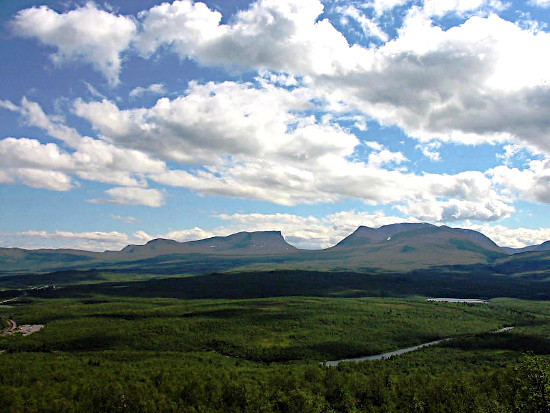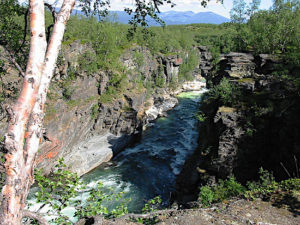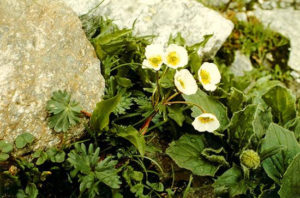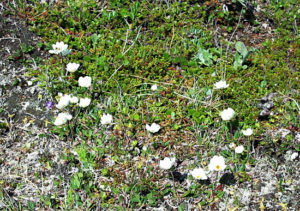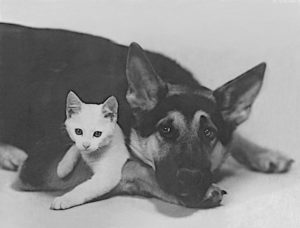Chapter 3 (Part 2) – Abisko and ‘Kungsleden’
We were warmly welcomed by the hostess at the Abisko tourist station, which was in those days a red house, and not even very big. Most guests rented little huts with one room and a small porch and ours had four bunk beds. Since we took all our meals at the tourist station, no cooking facilities were needed, even though I think there were some. Our little house was called Annersia, meaning ‘the other side’, as Arne figured out,’ in the northern Swedish dialect – the other side, that is, of the railroad. When John and I got back to Abisko in 2002, I tried to see if Annersia was still there, but of course I couldn’t even find the place where it had once been.
The tourist station itself had been completely rebuilt, very much enlarged and changed after it was almost entirely destroyed in a fire a couple of years after we were there in 1947. In 2002 I never dared tell anyone that I had been in Abisko in 1947. I would have been considered as a ghost from the past.
We loved the scenery, the big stream Abiskojokk, rapid water between rocky shores, in other regions there was marshy land with the famous cloudberries (hjortron), which make a delicious jelly. T here were flowers we had never seen previously and also the tiny intensely blue gentians. And of course we saw masses of the great Swedish botanist Carl von Linnæus’ own flower, linnea borealis. And birches. The only trees seemed to be the small white-barked birches – betula alba. As you climb up in the mountains, the birch forests give way to slopes and plateaus covered with willow bushes. Where the willow is rare there is always dwarf birch (betula nana) in masses until you get to the barren plateaus where next to nothing grows.
In fact, in the high mountains you do find, if you are lucky, the most wonderful ranunculus glacialis, in Swedish isranunkel, often next to a patch of snow since it thrives in an arctic climate. In English it is simply called glacier buttercup. We have, on a few rare occasions, seen them In the Austrian Alps as well.
There are also on the high plateaus plenty of dryas octopetala, which is of the rose family, even though it looks very much like an anemone. In Swedish we call it fjällsippa – sippa as if it were a Ranunculaceae. In English it’s called white mountain avens. In the Alps we have often seen high mountain valleys and plateaus that are not too arid, practically covered with these beautiful white flowers, called Silberwurz. It’s easy to tell from the leaves that it’ is not a Ranunculaceae like the ranunculus glacialis.
Jokk is the Sami word for a stream. That is one word everybody picks up and you never talk about stream any more. It’s always a jokk. The Sami language is close to Finnish and Estonian, and it is completely different from Swedish. It is a Finno-Samic language, a hypothetical subgroup of the Uralic family.
After a few days in Abisko, getting used to the air, taking little hikes and getting our muscles in shape, we set out on our 8-day trek south that was going to end up with the climbing of Kebnekajse, the highest mountain in Sweden. This path is the famous Kungsleden, the King’s Trail. It was started over a hundred years ago, in 1906, and so was the old tourist station.
The trail goes very far to the south, all in all 450 km. However, all I have ever known is the northern part as far down as to Kvikkjokk, and that last south of Kebnekajse was three years later. This time, in 1947, Kebnekajse was our goal, but there turned out to be some very extraordinary and unexpected events before the climbing of the highest mountain in Sweden. After Kebnekajse tourist station, there is a 19 km walk to Nikkaluokta, where you can get a bus to Kiruna, the northernmost city in Sweden.
_____________________
We had bought all the necessary equipment for hiking in the fjäll (the Swedish high mountains in northern Lapland). Even though summers in northern Lapland are very short, we still had to be prepared for very warm weather, but also for occasional cool days and chilly winds in high passes. As it turned out, northern Lapland had the best weather in all of Sweden that summer 1947.
We set out with our heavy backpacks, my three seniors carrying a bit over 20 kilos on their backs, as we set out. I was too young, and little for my age, to carry that load and my backpack was a bit smaller. The special backpacks we had bought for this trip had metal frames which the packs were attached to in order to keep them from clinging to your back, and it is also important to distribute the weight properly inside the pack so as not to put the heaviest weight at the bottom, on the small of your back.
The first stopover was just 15 km away from Abisko, at the hut Abiskojaure (jaure=lake) and it was a good warming-up exercise for the longer treks that were to follow. It was a beautiful place, and somehow we ended up spending two days there. We became very friendly with Park-Nisse, the National park guard who lived in a house about one kilometer from the tourist hut, which had two rooms, one for men and one for women.There were blankets so we didn’t need sleeping bags — and the same for all the other huts. He didn’t want to see too much of the tourists. Park-Nisse was a character.
We became fast friends because his two German shepherds accepted us immediately. They were dogs that didn’t usually like the tourists. And Mother, who never ceased to surprise us, somehow had the idea of scrubbing the floor that was quite dirty. Park-Nisse was so delighted that he said we could pick some flowers and put on the table, which we did of course. And that wasn’t all. He invited us to go to his hut and use his two fishing rods to catch some trout.
In fact, Park Nisse’ s two German shepherds came to have a very significant follow-up. When we got back to Malmö after this exceptional vacation, we decided to get a German shepherd too. We had had a collie dog when I was a little kid and he had learned to be my babysitter. He would stand or lie between me and the fireplace and, on a dock, between me and the water. Wherever we were, he would be all set to protect me. Obviously this is what Mother has told me much later.
We got a most handsome German shepherd and we all loved him as much as you can ever love a dog. And that’s a lot. We now had a cat and a dog and they were the best friends you can ever imagine.
After the war, we only had a cat and once it was a cat that Gun and I had found in Grandpa’s timber yard and who was completely wild. How we actually managed to catch him is a mystery. You just don’t catch wild cats. I am sure we were all scratched up after that experience, but I’ll never forget how we were lying on our bellies reaching in under the huge stack of timber, the kitten hissing and spitting and scratching. But we got him. He became the most docile cat I’ve ever had. I would put him in my baby carriage between sheets with his front paws over the edge of the top sheet.
Well, after that invitation we decided to spend a second day loafing and fishing. The two trout we caught were the best I’ll ever have in my life. They were not even one hour old when Mother fried them. And remember, this is a National Park and you’re not normally allowed to pick flowers or catch fish. But Park-Nisse was now our friend and we were exceptions. He was the law after all.
The somewhat embarrassing part was that Park-Nisse invited us to his house for coffee. We had looked through his grimy window and we were not very happy about his invitation. But what could we do. We accepted of course. Well, we managed to drink his coffee and we were not the worse for it. He was a rough fellow and he told us a lot of jokes, some of them a bit unsavory. I remember well that, among other things, he told us that he made his own bread because the baker in Abisko had foot sweat.
In northern Lapland all the little streams that trickle down from the melting snow have water as clean as can be. So what you definitely don’t need to carry is water. As soon as you cross a little jokk, you get your cup out and savor the wonderful, cool water. But just a couple of sips each time, no matter how thirsty you are. Another one of Park-Nisse’s stories is about the two tourists who didn’t know anything about the mountains. They were told by some jokers that they had to carry their own water throughout Kungsleden and that you needed a lot of it since you sweat so much from the walking and climbing. So the two guys set out for Abiskojaure carrying a bucket of water between them.
____________________
The tourist huts in those days were a lot less comfortable than they are today. You carried your own water from the pump into the kitchen and there were no gas stoves. You made a fire to cook your food, the vacuum packed pea soup or brown beans or whatever was on the menu for the evening. But often when you arrived in a hut the fire was already going and you were in luck. You said thanks to the people who were already in the hut and that was all. There were also no shops at the time between Abisko and Kebnekajse Tourist Station, which was of course even then well equipped with everything you might need.
The one problem is of course the mosquitoes. They are all over – and THEY ARE BIG. We used what we call jungle oil, a mosquito repellent that you rubbed into your skin, and we also wore hats. A scarf isn’t enough protection. Those fierce beasties bite you right through it. On our way through the forest, where the mosquitoes are myriad, we used to break off birch branches and keep slashing our heads and necks and arms with those to brush off the mosquitoes as we were walking. Once you get up on the heights you leave them behind since there are no ponds or marshes where they can hatch.
The hiking wasn’t like a walk on the Champs-Elysées. Our second stretch was 20 kilometers to Alesjaure. We were in good shape but I remember vividly how relieved we were after the uphill and downhill walks when we finally caught sight of the hut that was to be our hotel for the night.
I believe it was on this stretch that we were suddenly in front of a wide but shallow jokk. Well, what do you do? We hadn’t been forewarned, but there was only one thing to do. We had to get prepared to wade across. We took off our boots and tied them onto our backpacks, put the socks inside them, folded our pants up to our knees and set out into the fast flowing water. The bottom was stony and somewhat slippery and you had to tread very carefully so as not to lose your balance. But of course we made it, even though I bet it took us a good while to cross that wide jokk. When we got to the other side, it was time for rest, drying of feet and putting socks and boots back on. It had been fun and we laughed a lot, but only when it was all over. Today there is of course a bridge over that jokk.
Very often there was no visible path at all and you had to follow the cairns (röse) that were set up at fairly reasonable intervals to indicate the trail. We had army maps (generalstabskarta) that we followed carefully and we used our compass too. We always knew where we were on the map.
Conditions have changed considerably since 1947. I have been told that long planks have now been put down across marshes and in lots of places where we got our boots and socks pretty wet. Also suspension bridges have been built over some of the places where we waded across the streams. The huts have become more comfortable, but I do believe that if you want to take a shower, you still have to depend on the occasional water fall where you get yourself under almost ice cold water from the melting snow up high. I vividly remember that once we were so hot and sweaty that we actually went swimming in a jokk in 7°C water. That swim was short but invigorating.
_______________________
Once you emerge on your way uphill from the green forests down in the valleys, you get onto the plateaus or the stony paths next to mountain ridges. You come out of teh forests with gnarled birches, the ground covered with blueberry and lingonberry shrubs, various kinds of heather and here and there patches of linnea.You are alone with nature and you feel the enormity of the wilderness surrounding you, the arid stretches where very little grows.
A deep feeling of awe came over me as I looked ahead and around me and there were nothing but mountains, barren moors and occasional snow patches. Birds flying by overhead once in a while, but mainly nothing but silence. No more trickling of little streams, no voices heard. Just nature and me. And the silence.
A feeling came over me that was almost religious, but some kind of religion that would be one with the nature around me and where there would be no place for a god. Neither a revengeful nor a merciful god. This was peace and there had never been a war. Wars did not exist in this world of mine. As I was looking around me, I felt as if I was being one with the wilderness and the peace that was almost tangible.
______________________
One day between Alesjaure and Sälka we climbed up to a pass, Tjäktjapasset, that is at 1150 m altitude, the highest point on the 130 km of trail from Abisko to Kebnekajse. It began to snow as we were resting there. A wind shelter has since been constructed at this pass but back in my days there was nothing but rocks and barren ground. We sat down to rest after the steep climb and Mother and Arne drank the last few sips of the snaps they had brought with them and emptied their little flask. It was chilly. There was a general buttoning-up of anoraks all the way to the chin. This temperature is practically the rule in places like this even in the middle of the short northern summer. At the time, that day’s trek was 25 km, but a new hut has been added halfway, Tjäkta stugan, to make the long trek more available to everybody.
John and I have later had far worse weather than that in the middle of summer in the Austrian Alps. We were on the huge Brandner Gletscher in Vorarlberg, on our way to the Mannheimerhütte in early August 1985, when black clouds started coming up behind us, from Switzerland. Luckily we were planning on spending the night in the Hütte. That was a true adventure, one of many in the Alps, and we were still young! But that’s for another chapter.
Continued: Part Three – Reindeer branding
